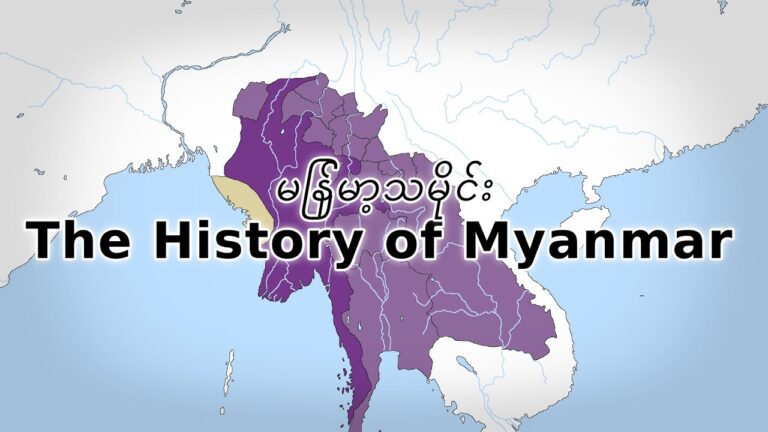Visit Siem reap and Angkor temples ( Full pro guide 2025 )
The Ultimate Guide to Siem Reap: Exploring Cambodia’s Ancient Wonder
Siem Reap, the gateway to the magnificent Angkor temples, is a destination that seamlessly blends ancient history with modern charm. This comprehensive guide will take you through the myriad experiences this captivating city has to offer, from its world-renowned archaeological sites to its vibrant local culture and cuisine.
1. Exploring the Angkor Archaeological Park
Angkor Wat: The Crown Jewel

No visit to Siem Reap is complete without exploring the majestic Angkor Wat, the largest religious monument in the world. Built in the early 12th century by King Suryavarman II, this architectural marvel stands as a testament to the grandeur of the Khmer Empire .Angkor Wat’s intricate bas-reliefs, which depict scenes from Hindu mythology, and its five central towers symbolizing Mount Meru, the center of the universe in Hindu cosmology, make it a must-see attraction. The temple’s westward orientation and the anticlockwise direction of its bas-reliefs suggest it was also used as a mausoleum for the king .To fully appreciate Angkor Wat’s beauty, consider visiting at sunrise. The sight of the temple’s silhouette reflected in the surrounding pools as the sun rises is truly breathtaking and offers excellent photography opportunities.
Angkor Thom: The Great City

Just north of Angkor Wat lies Angkor Thom, the last capital of the Khmer Empire. Established by King Jayavarman VII in the late 12th century, this vast complex covers an area of 9 square kilometers and is enclosed by a wall and a moat .At the heart of Angkor Thom stands the Bayon Temple, famous for its 216 serene stone faces believed to represent the bodhisattva Avalokiteshvara or a fusion of the king and Buddha . The city also includes other significant structures such as the Baphuon, Phimeanakas, and the Terraces of the Elephants and the Leper King .Exploring Angkor Thom provides a fascinating insight into the urban planning and architectural prowess of the ancient Khmer civilization. The sheer scale of the complex and the intricacy of its carvings are awe-inspiring.
Ta Prohm: Nature’s Embrace

For a truly atmospheric experience, visit Ta Prohm, often referred to as the “Tomb Raider Temple” due to its appearance in the eponymous film. Built in the late 12th century by King Jayavarman VII, Ta Prohm was originally a Buddhist monastery and university .What sets Ta Prohm apart is the way nature has reclaimed the temple. Massive trees intertwine with the ruins, creating a hauntingly beautiful scene that seems frozen in time. The temple has been left largely in its natural state, offering visitors a glimpse of how the entire Angkor complex might have appeared when it was first rediscovered by European explorers in the 19th century.
Banteay Srei: The Citadel of Women

Located about 25 kilometers northeast of the main Angkor complex, Banteay Srei is a hidden gem that shouldn’t be missed. Often referred to as the “Citadel of Women,” this 10th-century temple is renowned for its intricate carvings and pink sandstone construction .Despite its smaller size compared to other Angkor temples, Banteay Srei’s exquisite decorations and detailed carvings make it a favorite among art enthusiasts. The temple’s remote location also means it’s often less crowded, allowing for a more peaceful exploration.
Beng Mealea: The Jungle Temple
For those seeking a more adventurous experience, Beng Mealea offers a glimpse into what the Angkor temples might have looked like before restoration efforts began. Located about 40 kilometers east of the main Angkor sites, this sprawling temple complex has been largely overtaken by the jungle .Built in the early 12th century, Beng Mealea is similar in style to Angkor Wat but offers a more raw and untamed experience. Its remote location and overgrown state give it a mysterious and adventurous appeal, making it perfect for those looking to channel their inner explorer.
2. Immersing in Local Culture and Experiences
Phare, The Cambodian Circus
For a unique cultural experience that blends traditional and contemporary elements of Cambodian performance art, don’t miss Phare, The Cambodian Circus. This isn’t your typical circus; it tells compelling stories of Cambodian life through a blend of theater, music, dance, and circus arts .The performances are deeply rooted in Cambodian culture and often reflect themes of resilience and hope, making it a must-see for those interested in understanding the modern cultural landscape of Cambodia. The energy and skill of the performers are truly impressive, and the shows provide both entertainment and insight into Cambodian society.
Angkor National Museum

To deepen your understanding of Khmer history and culture, a visit to the Angkor National Museum is essential. The museum features eight themed galleries that showcase the evolution of Khmer civilization through a combination of artifacts and state-of-the-art multimedia presentations .Exhibits cover the origins of the Khmer Empire, the architectural marvels of Angkor Wat, daily life in the empire, and the spiritual beliefs that shaped Khmer culture. The museum provides valuable context for the temples you’ll explore, making it an excellent starting point for your Siem Reap adventure.
Cambodian Cultural Village

For a comprehensive look at Cambodia’s diverse ethnic groups and their traditions, visit the Cambodian Cultural Village. This living museum offers a fascinating glimpse into the cultural richness of Cambodia through dance performances, traditional music, handicraft exhibitions, and village recreations .The Cultural Village is an excellent place to learn about the different ethnic groups that make up Cambodia’s population, their unique customs, and traditional ways of life. It’s an educational and entertaining experience that highlights the cultural diversity of the country.
Local Markets and Shopping

Immerse yourself in local life by exploring Siem Reap’s vibrant markets. The Old Market (Psar Chaa) is a bustling hub where locals shop for fresh produce, meats, and seafood. It’s also a great place to find silk scarves, clothing, and souvenirs .For evening shopping, head to the Angkor Night Market, which features over 240 shops housed in unique Khmer-style huts . Here, you can find a wide array of goods, including paintings, wood carvings, and local delicacies.Don’t miss Pub Street, the heart of Siem Reap’s nightlife, which offers a mix of dining, shopping, and entertainment options . The lively atmosphere and variety of shops make it a popular spot for both tourists and locals.
3. Natural Attractions and Outdoor Activities
Phnom Kulen National Park

For nature lovers, Phnom Kulen National Park offers a refreshing escape from the temple-hopping. This pristine natural area spans over 37,000 hectares and is renowned for its lush forests, cascading waterfalls, and significant archaeological sites .The park is home to the picturesque Phnom Kulen waterfall, a popular spot for both locals and tourists to enjoy a refreshing dip. You can also explore ancient temples and ruins, such as Prasat Krau Romeas, and visit Kbal Spean, known as the River of a Thousand Lingas, which features intricate carvings .
Tonle Sap Lake and Floating Villages

A visit to Tonle Sap Lake, the largest freshwater lake in Southeast Asia, offers a unique glimpse into a way of life that has remained largely unchanged for centuries. The lake is home to several floating villages, where entire communities live and work on the water .Take a boat tour to explore these fascinating villages, such as Kampong Phluk, and observe the daily activities of the residents. The lake’s ecosystem supports a rich biodiversity, making it a captivating destination for nature enthusiasts and bird watchers .
4. Culinary Delights and Dining Experiences

Siem Reap’s culinary scene is a delightful mix of traditional Khmer cuisine and international flavors. Don’t miss the opportunity to try local specialties such as Fish Amok, a fragrant coconut milk curry often made with fish, and Lok Lak, a stir-fried beef dish served with a tangy lime and pepper sauce.For an immersive culinary experience, consider taking a food tour or cooking class. Siem Reap Food Tours offer both morning and evening tours that take you to local spots off the beaten path, allowing you to experience authentic Cambodian street food .For a unique dining experience, enjoy an Apsara Dance Show while savoring your meal. These traditional Khmer dance performances add a cultural dimension to your dining experience, offering insight into Cambodia’s rich artistic heritage.
5. Accommodation Options
Siem Reap offers a wide range of accommodation options to suit every budget and preference. For luxury seekers, high-end hotels like Sofitel Royal Angkor Resort, Raffle Grand Hotel, and Park Hyatt Hotel offer elegant designs and excellent service .Mid-range options such as Bayon Modern Residence provide comfortable stays with amenities like spacious rooms and swimming pools. For budget-conscious travelers, hostels like Lub d Cambodia Siem Reap and The Twizt – Lifestyle Hostel & Hotel offer affordable and social accommodation options .When choosing your accommodation, consider factors such as proximity to major attractions, amenities offered, and recent guest reviews to ensure a comfortable and enjoyable stay.
6. Getting Around Siem Reap
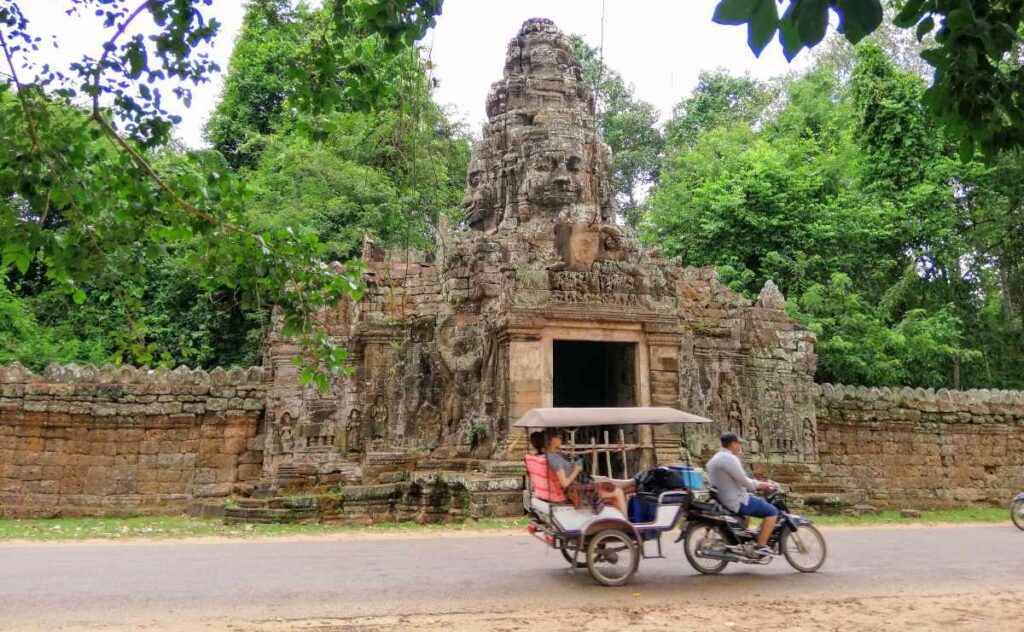
Navigating Siem Reap is relatively easy, with several transportation options available. Tuk-tuks are the most popular and quintessential mode of transport, offering an affordable and authentic way to explore the city. The average cost for hiring a tuk-tuk is about $12-15 per day .For those who prefer more structured experiences, guided tours are an excellent option. These often include transportation in air-conditioned buses or vans and knowledgeable guides who can provide insights into the history and culture of the sites visited.More adventurous travelers might opt to rent bicycles or motorbikes, which offer the freedom to explore less accessible areas at your own pace . For longer trips or when traveling with a group, taxis and car rentals are also available.
7. Best Time to Visit and Trip Planning Considerations
The best time to visit Siem Reap largely depends on your preferences for weather and crowd levels. The dry season, from November to April, offers cooler and drier weather, making it ideal for exploring the temples and outdoor activities. However, this is also the peak tourist season, especially from December to January, when crowds are larger and prices are higher .The wet season, from May to October, brings frequent rains but fewer crowds and lower prices. While the rains can be heavy, they are usually predictable and occur in the afternoon or at night, leaving mornings and evenings relatively dry .When planning your trip, consider timing your visit to coincide with local festivals such as the Khmer New Year in April or the Angkor Wat International Half Marathon in December for a more immersive cultural experience.Remember to pack light, breathable clothing due to the hot and humid climate, but also bring modest attire for visiting religious sites . Most visitors require a visa, which can be obtained upon arrival or online. While the local currency is the Cambodian Riel, USD is widely accepted, especially for larger transactions.
Travel Guide to Exploring the Angkor Temples

Welcome to the magical world of the Angkor Temples, a breathtaking testament to the ingenuity of the Khmer Empire that ruled Cambodia from the 9th to the 15th centuries. This extensive complex is a UNESCO World Heritage Site, featuring some of the most stunning architecture and intricate stone carvings in the world. Whether you’re an avid history buff, a photography enthusiast, or simply seeking adventure, exploring the Angkor Temple Complex should be at the top of your travel bucket list.In this comprehensive guide, we’ll delve into everything you need to know about visiting the Angkor Temples, including essential tips, must-see sites, local culture, and more.
1. Introduction to the Angkor Temples
The Angkor Temples are not just a collection of ancient ruins; they are a glimpse into the rich history and culture of the Khmer Empire. Spread over an area of 162.6 hectares, the temple complex includes over a thousand structures, each with its unique story and architectural style. From the grand scale of Angkor Wat—the largest religious monument in the world—to the mystical charm of Ta Prohm, known for its tree-clad ruins, these temples are a photographer’s dream and a history lover’s paradise.
2. Planning Your Visit
Best Time to Visit
The best time to visit the Angkor Temples is during the cool dry season, which runs from November to February. The weather during these months is pleasant, with lower humidity and cooler temperatures, making it perfect for exploring. However, this is also the peak tourist season, so expect larger crowds.
Getting There
Siem Reap is the gateway to the Angkor Temples, and it’s well-connected by air, road, and even boat. The nearest airport is Siem Reap International Airport, which has flights from major cities in Southeast Asia. From the airport, you can easily take a taxi or tuk tuk to your accommodation.
Entrance Fees
To enter the Angkor Temple Complex, you need to purchase a ticket. As of October 2023, the prices are as follows:
1-day pass: $37
3-day pass: $62
7-day pass: $72
You can purchase your ticket at the official ticket office near the entrance to the temple complex. Make sure to keep your ticket on you at all times, as it will be checked at various points.
3. Must-See Temples
Angkor Wat

No visit to the Angkor Temples is complete without exploring Angkor Wat. Built in the early 12th century, this masterpiece was originally dedicated to the Hindu god Vishnu and later transformed into a Buddhist temple. Its grandeur is unmatched, with five lotus-shaped towers symbolizing Mount Meru, the center of the universe in Hindu cosmology.
Highlights:
Stunning sunrise views
Intricate bas-reliefs depicting scenes from Hindu mythology
The iconic reflecting pool
Bayon Temple

Located in the heart of Angkor Thom, Bayon Temple is famous for its 216 stone faces, believed to represent Avalokiteshvara, the bodhisattva of compassion. The temple’s unique architecture features a combination of Buddhist and Hindu elements, making it a fascinating site to explore.
Highlights:
The serene smiles of the stone faces
Intricate carvings depicting daily life during the Khmer Empire
A maze-like layout that encourages exploration
Ta Prohm

Ta Prohm is perhaps the most photogenic temple in the complex, thanks to the enormous trees that have intertwined with its ruins. Made famous by the Tomb Raider movie, this temple provides a hauntingly beautiful glimpse into nature reclaiming its territory.
Highlights:
Massive tree roots enveloping the stone structures
A sense of romantic decay
A perfect spot for photography
Banteay Srei
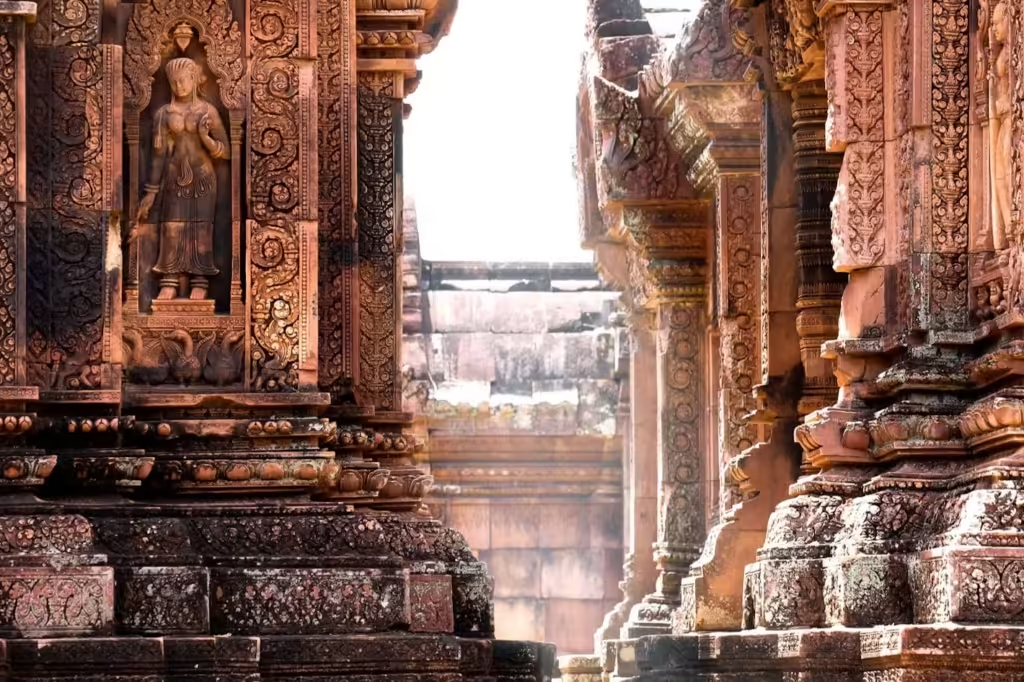
Often referred to as the “Citadel of Women,” Banteay Srei is a must-visit temple located about 30 km from Siem Reap. Known for its exquisite pink sandstone and detailed carvings, this temple is dedicated to the Hindu god Shiva.
Highlights:
Intricate carvings that depict scenes from Hindu mythology
Smaller and more intimate than the other temples
A peaceful atmosphere away from the crowds
Angkor Thom

Angkor Thom is a vast city complex that served as the last capital of the Khmer Empire. It is surrounded by a massive wall and features several significant structures, including the Bayon Temple and the Terrace of the Elephants.
Highlights:
The South Gate, adorned with impressive stone carvings
The Terrace of the Leper King, featuring stunning reliefs
The Royal Palace site, showcasing the grandeur of the Khmer Empire
Other Notable Temples
While the above temples are the most famous, there are many other notable temples worth visiting:
Preah Khan: A vast temple complex that combines both Buddhist and Hindu elements.
Neak Pean: A unique temple built on an island in the middle of a pool.
Beng Mealea: A jungle temple that remains largely unrestored, offering an adventurous experience.
Kbal Spean: An archaeological site featuring riverbed carvings dedicated to Hindu deities.
4. Temple Tours
Self-Guided Tours
If you prefer to explore at your own pace, consider a self-guided tour. You can download a free audio guide or use a map to navigate the temple complex. This option allows you to spend as much time as you want at each site.
Guided Tours
For a more enriching experience, you might opt for a guided tour. Local guides can share fascinating anecdotes and historical context that you might miss otherwise. Many companies offer half-day or full-day tours tailored to your interests.
Tuk Tuk Tours

One of the most popular ways to explore the Angkor Temples is by tuk tuk. Hiring a driver for the day allows you to cover more ground while enjoying the open air. Make sure to negotiate the price beforehand, and don’t forget to bring some cash for entrance fees!
5. Local Culture and Community

While exploring the temples, take some time to engage with the local community. Siem Reap is known for its rich culture, and you can find traditional Khmer arts, local markets, and delicious Cambodian cuisine throughout the area.
Local Markets: Visit Psar Chas (Old Market) to experience the hustle and bustle of local life. Shop for souvenirs, handicrafts, and fresh produce.
Community Projects: Consider supporting local NGOs like Phare Ponleu Selpak, which promotes traditional arts and provides education to local youth.
6. Practical Tips for Visiting
What to Wear
Dress modestly while visiting the temples. It’s important to cover your shoulders and knees as a sign of respect. Lightweight, breathable clothing is ideal, as temperatures can soar during the day.
Essential Items to Bring
- Water Bottle: Stay hydrated, especially while exploring under the sun.
- Sunscreen and Hat: Protect yourself from the sun’s rays.
- Comfortable Shoes: You’ll be doing a lot of walking, so wear sturdy footwear.
- Camera: Capture the stunning beauty of the temples!
Safety Tips
- Be aware of your surroundings and keep your belongings secure.
- Respect the local customs and traditions.
- Follow the guidelines provided by your tour guide or temple staff.
Exploring the Angkor Temples is an unforgettable journey through time, offering a glimpse into the incredible achievements of the Khmer Empire.
Whether you’re marveling at the grandeur of Angkor Wat, getting lost among the roots of Ta Prohm, or wandering the serene pathways of Banteay Srei, each temple has a story to tell.
So pack your bags, grab your camera, and get ready for an adventure that will leave you in awe! The Angkor Temples await, and they promise to give you memories that will last a lifetime.
Happy travels, and may your exploration of the Angkor Temples be as funky and fresh as your spirit!
A Comprehensive History of the Angkor Temples
The Angkor temples, located in present-day Cambodia, stand as a testament to the grandeur and sophistication of the Khmer Empire that flourished between the 9th and 15th centuries CE. This architectural marvel, with its intricate designs and vast scale, offers a window into the religious, cultural, and political landscape of medieval Southeast Asia.
Origins and Rise of the Khmer Empire
The story of Angkor begins with the rise of the Khmer Empire in 802 CE, when Jayavarman II declared himself “chakravartin” or “universal ruler” . This marked the beginning of a powerful state that would dominate much of Southeast Asia for centuries.
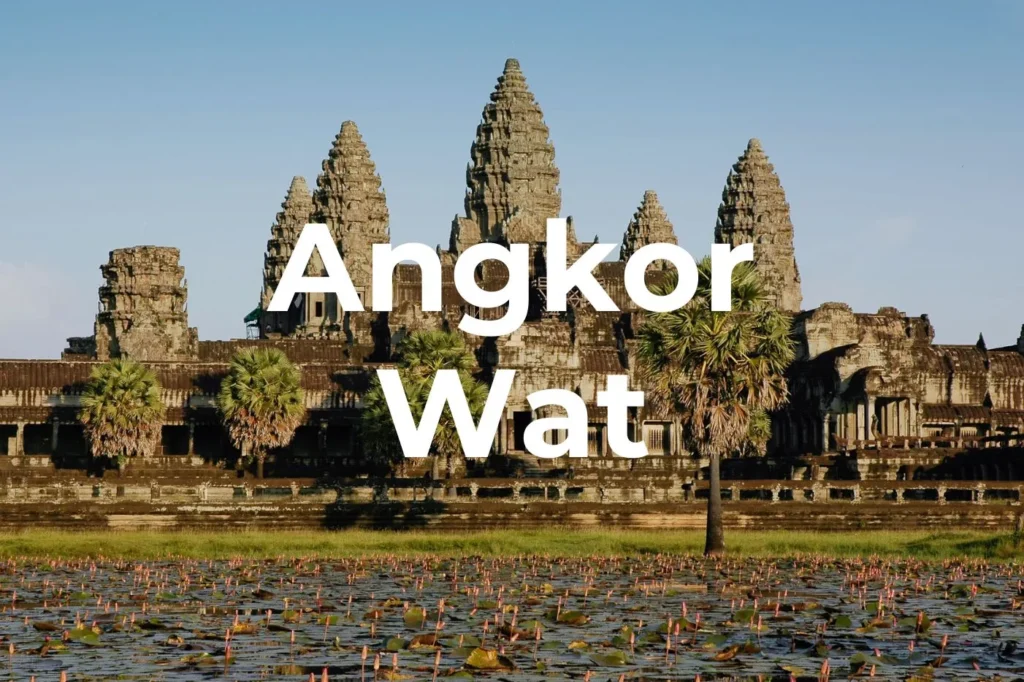
The empire’s origins can be traced back to earlier kingdoms such as Funan and Chenla, which had already established a tradition of Indianized culture and extensive trade networks in the region. Jayavarman II’s successors continued to expand the empire’s territory and influence.
Notably, Indravarman I (877-889 CE) initiated significant architectural projects, including the construction of large reservoirs and temples. His son, Yasovarman I, moved the capital to Angkor and established the city of Yasodharapura, setting the stage for the grand constructions that would follow.
The Golden Age of Temple Construction
The 11th to 13th centuries marked the zenith of the Khmer Empire and witnessed the most significant period of temple building.

The crowning achievement of this era was undoubtedly Angkor Wat, commissioned by King Suryavarman II in the early 12th century. Originally dedicated to the Hindu god Vishnu, Angkor Wat is renowned for its grandeur and intricate bas-reliefs depicting Hindu epics .Angkor Wat’s design exemplifies the temple-mountain style, symbolizing Mount Meru, the center of the universe in Hindu cosmology. Its five towers rise to a height of 65 meters, surrounded by a series of enclosures and galleries that create a miniature replica of the cosmos in stone.
Religious Transformation and Expansion
A significant shift occurred in the late 12th century under the reign of Jayavarman VII (1181-1220 CE). Following the empire’s embrace of Buddhism, Jayavarman VII embarked on an ambitious building program that included the construction of the Bayon Temple and the city of Angkor Thom .The Bayon Temple, located at the center of Angkor Thom, is famous for its 54 towers adorned with enigmatic smiling faces.
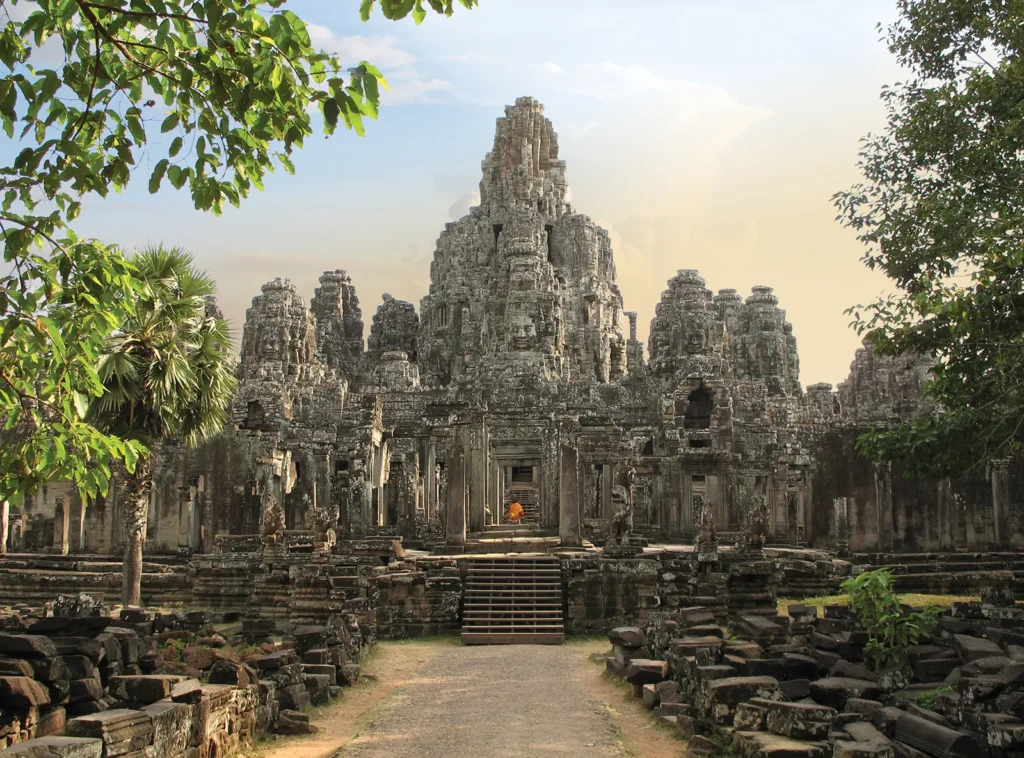
These faces are believed to represent either the Bodhisattva Avalokiteshvara or Jayavarman VII himself, symbolizing the king’s devotion to Buddhism and his desire to integrate the empire’s diverse religious practices. Another notable temple from this period is Ta Prohm, commissioned by Jayavarman VII as a Buddhist monastery and university. Unlike other temples that have been extensively restored, Ta Prohm has been left largely in its natural state, with trees growing out of the ruins, creating a unique and picturesque scene that symbolizes the harmony between human creation and nature.
Architectural Marvels and Construction Techniques
The Angkor temples showcase the Khmer Empire’s advanced understanding of architecture and engineering. The primary materials used were sandstone and laterite, with sandstone preferred for its fine grain and ability to be intricately carved . The builders employed sophisticated techniques such as mortise and tenon joints to fit stones together without mortar, ensuring precise alignment and stability .The temples were often integrated with vast water management systems, including moats, reservoirs, and canals. This hydraulic engineering not only served practical purposes but also enhanced the aesthetic and symbolic aspects of the temple complexes .The intricate bas-relief carvings that adorn many of the temples were created using chisels and hammers, depicting a wide range of subjects from religious iconography to scenes of daily life. These carvings provide valuable insights into the culture and society of the Khmer Empire .
Decline and Abandonment
The decline of Angkor began in the 15th century, influenced by a combination of environmental, political, and economic factors. Severe climatic fluctuations, including prolonged droughts and intense monsoons, disrupted the city’s extensive water management system, straining resources and infrastructure .Political pressures from neighboring kingdoms, particularly the Tai kingdom of Ayutthaya, also contributed to Angkor’s decline.
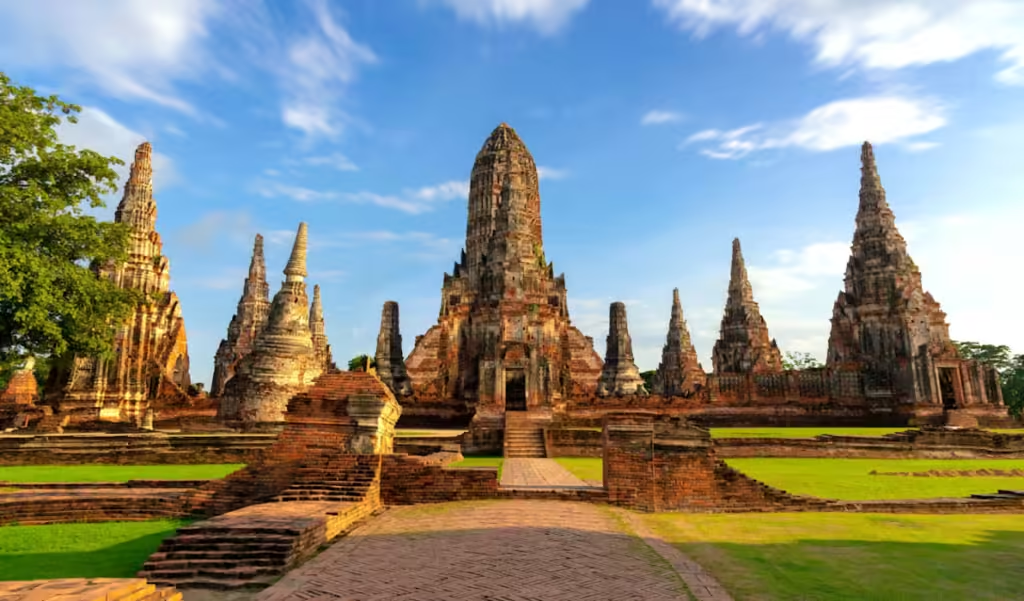
Recorded Tai attacks on Angkor occurred in 1369, 1389, and 1431, with the latter often cited as the event that led to the city’s abandonment . However, recent studies suggest that the decline was more gradual, with the ruling elite leaving Angkor over a century before the supposed sacking in 1431.
Economic shifts also played a role, as maritime trade with China increased, drawing economic activity towards coastal ports. This shift likely drew the Khmer elite away from Angkor to more profitable trading centers along the Mekong Delta .
Rediscovery and Conservation
The narrative of Angkor’s “rediscovery” by Western explorers in the 19th century is somewhat misleading, as the site was never truly lost to the local Khmer people. However, Henri Mouhot’s visit in 1860 and subsequent publication of his travel diary captured the imagination of the European public, bringing Angkor to global attention.

Early conservation efforts began in the early 20th century, led by the French École Française d’Extrême-Orient (EFEO). These efforts involved clearing vegetation, stabilizing structures, and documenting the architectural and artistic features of the temples.
In 1992, Angkor was designated as a UNESCO World Heritage site, bringing international attention and resources to its preservation. Today, conservation efforts involve a complex interplay of archaeological research, architectural restoration, and sustainable tourism management. These efforts aim to balance the preservation of this invaluable historical site with the demands of modern tourism and development .
Conclusion
With its stunning temples, rich history, and vibrant culture, Siem Reap is a must-visit destination in Southeast Asia. Whether you’re exploring the Angkor Temple Complex, indulging in local food, or engaging with the community, every moment spent in this city is filled with wonder.
So pack your bags, grab your camera, and get ready for an unforgettable adventure in the heart of Cambodia!
Remember, the best way to experience Siem Reap is to take your time, enjoy the journey, and soak in the beautiful sights and sounds of this enchanting city. Happy travels!
WHO AM I ?
Hello! I’m Eric, a French Australian citizen based between Australia, Asia and Bali and I love to travel and experience the world. I generally like outdoor activities, wellness, great food and venues , party and real local adventures ! I am a Yoga practitioner and fitness lover
I created this blog because I love to travel and I want to share my experiences with others. I’ve been traveling since I was a child, and I’ve been to over 50 countries. I’ve seen some amazing things and met some amazing people, and I want to help others experience the same things.

I believe that travel is one of the best ways to learn about the world and about yourself. When you travel, you’re forced to step outside of your comfort zone and experience new things. You learn about different cultures, different religions, and different ways of life. You also learn about yourself, your strengths, and your weaknesses.
Travel can also be a great way to make new friends. When you’re traveling, you’re surrounded by people from all over the world, and you’re all in the same boat. You’re all there to explore and experience new things, and that can create a bond between people.
Let’s connect together!
I hope that my travel blog will inspire others to travel and to see the world. I also hope that it will help people to learn about different cultures and to become more open-minded.


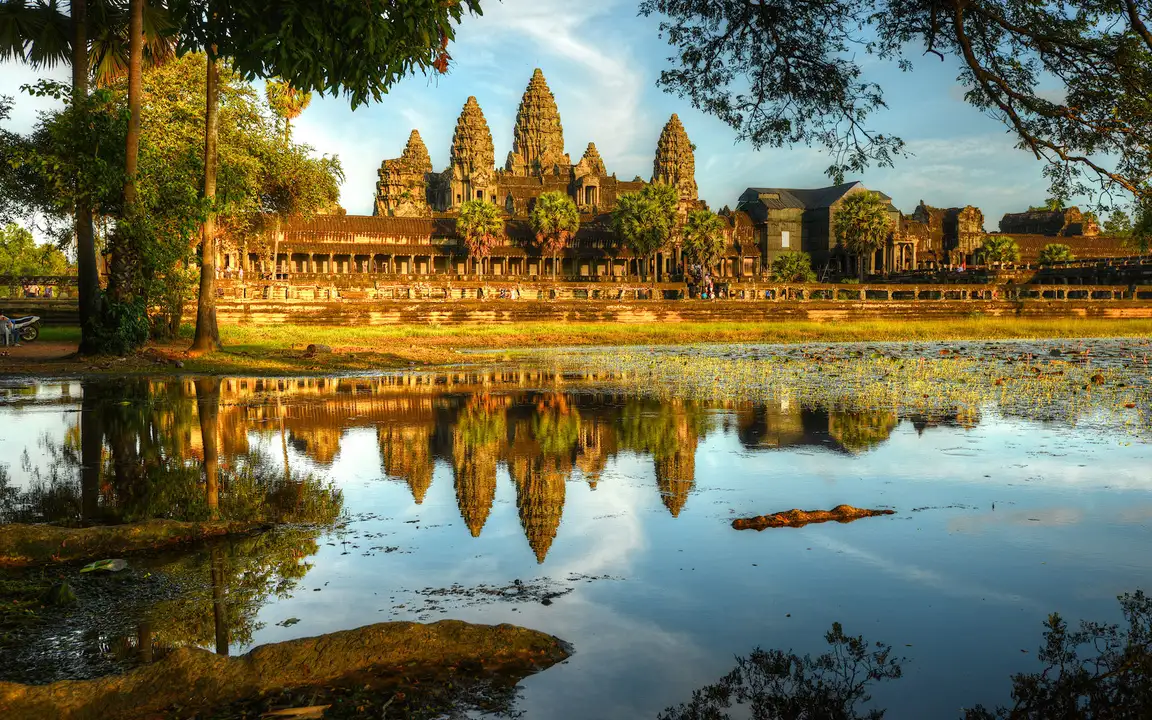
![Best Itinerary Myanmar [ FROM TRAVEL BLOGGER 2025 ]](https://funkyfreshtravels.com/wp-content/uploads/2025/04/Myanmar-Itinerary-10-Days-768x439.jpg)
![Itinerary Sri Lanka [ PRO TRAVEL BLOGGER 2025 ]](https://funkyfreshtravels.com/wp-content/uploads/2025/04/1406974336-768x512.jpg)
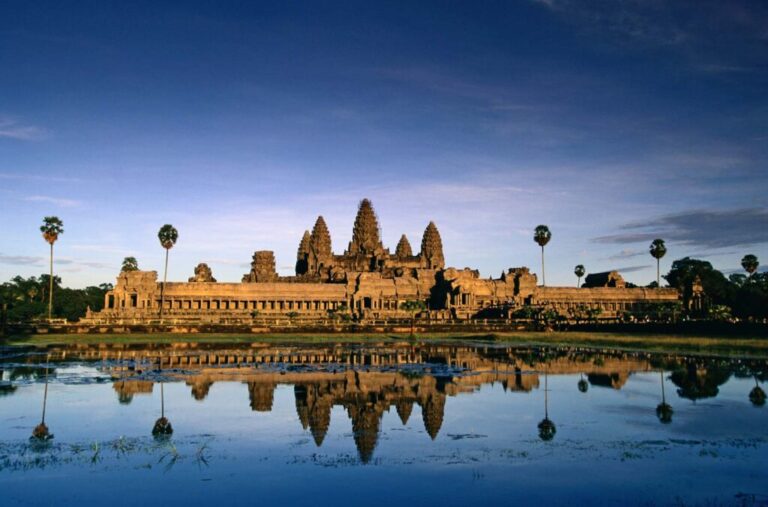

![Best beaches in Cambodia [ IG pictures spots ] 2025](https://funkyfreshtravels.com/wp-content/uploads/2025/04/cambodia_beaches_2-768x512.jpg)
